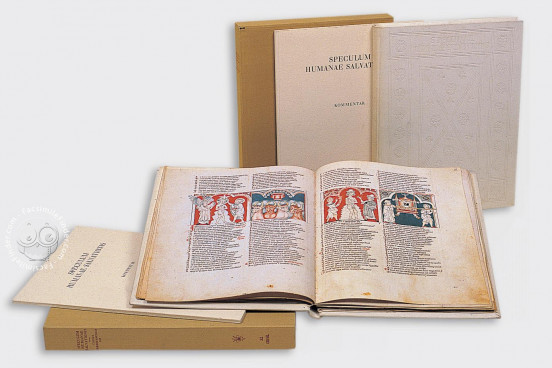This is one of the first and most exceptional manuscripts containing the Speculum Humanae Salvationis or "Mirror of Human Salvation" and is preserved in the collections of the Benedictine Abbey of Kremsmünster, Austria. Its 192 feather drawings possess a great 'idea of space,' are sometimes in red and blue color and allow the reader to fully immerse in the mysteries of the Christian faith.
The Speculum Humanae Salvationis: Unique in Many Ways
Not only is this codex among the first decorated manuscripts of the Speculum Humanae Salvationis, but it is also the first ever bilingual version with the original Latin and an abridged German text present side-to-side. This 'mirror of human Redemption' by Jesus and the Virgin is somehow a picture Bible that includes carefully selected episodes from the two Testaments with the aim of providing a summary of the contents of Christian belief.
The Illuminations: a Mirror to the Fourteenth Century Life
Apart from its contents, the Speculum Humanae Salvationis captivates readers with its simplistic yet profound illustrations. The figures, depicted in the same color as the parchment, starkly contrast against the red or blue backgrounds. The characters' expressions exude amiability and charm, creating a sense of connection with the reader. Conversely, the faces of malevolent characters are shaded in black. One of the most intriguing aspects lies in the inclusion of everyday objects within the illustrations, akin to a photograph, allowing us to glean insights into fourteenth-century culture through the clothing, architecture, and common items of the people depicted.
Religious Meditation in the Late Middle Ages
The list of behavioral examples derived from the Bible, aimed at encouraging reader meditation, is meticulously structured in the Speculum Humanae Salvationis. It begins by presenting an "anti-typus" - a character or situation from the New Testament that is mirrored by three relevant and similar episodes from the Old Testament, which appear to foreshadow or anticipate the anti-typus. These episodes not only invite readers to reflect on the scenes but also provide a concise summary of God's plan of salvation, allowing the faithful to perceive the Bible as a coherent whole.
With its extensive depictions, the Speculum Humanae Salvationis quickly gained popularity and became one of the most widely cherished texts in the late Middle Ages.
We have 1 facsimile edition of the manuscript "Kremsmünster Mirror of Human Salvation": Speculum Humanae Salvationis facsimile edition, published by Akademische Druck- u. Verlagsanstalt (ADEVA), 1972
Request Info / Price
